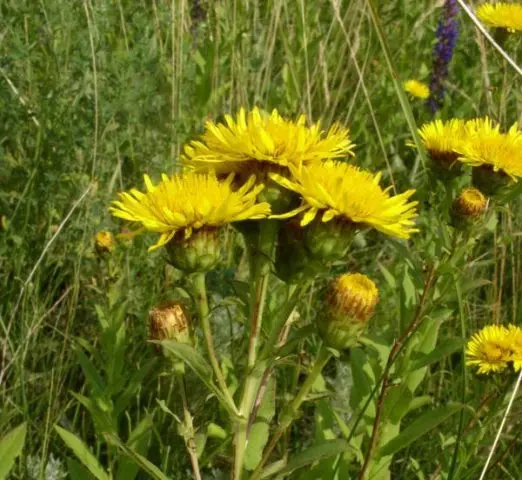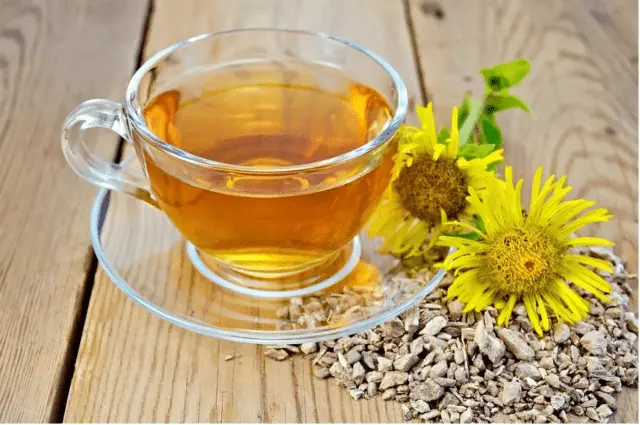Contents
Elecampane willow has been known since ancient times as an effective medicinal plant. It was used to treat many ailments even by Hippocrates and Galen. According to old beliefs, elecampane got its name due to the fact that there was an opinion that it had nine magical powers. The medicinal part of the plant is mainly the roots, they are used most often. Before use, they must be processed in a special way.
Botanical description of the plant
Williferous elecampane is a perennial herbaceous plant with a long, straight stem up to 80 cm tall. The leaf blades are arranged alternately, the venation is pinnate. The shape is elongated, with pointed edges, the structure is leathery.

Leaves come off the stem at right angles
The flowers of the plant are yellow with a golden tint, most often solitary. Extreme reed, all others are tubular. Pistil with lower ovary, bifid stigma, five stamens. Flower in full bloom up to 35 mm in diameter. The plant begins to bloom in July and continues until August. The fruits of willow-leaved elecampane are bare achenes.
It is during flowering that it is desirable to harvest grass for its subsequent use for medicinal purposes. It is important to collect the plant away from roads and industries. After collecting, it is necessary to sort the grass, throwing out all the spoiled ones, and then rinse, tie up in a well-ventilated place. The shelf life of a properly collected herb is no more than 2 years.
The chemical composition of the plant has not yet been fully studied, but it is known that it contains many useful substances. These include:
- essential oils;
- tocopherol;
- ascorbic acid;
- polysaccharides;
- inulin;
- flavonoids;
- gum;
- alkaloids.
It is the rich chemical composition that determines the beneficial properties of elecampane.
Distribution area
Elecampane is found in many areas of the steppe, forest-steppe and forest zones of the European part of Our Country. It also grows in Ukraine, Belarus, Moldova and some parts of Central Asia. Occasionally found in Eastern and Western Siberia, in the Far East – in the Amur Region, Primorye and the Kuril Islands.
It prefers to grow among shrubs and on forest lawns, on edges and meadows.

Elecampane often can be found along the banks of rivers and lakes, as well as on chalk slopes.
Healing properties of willow-leaved elecampane
Almost all parts of the plant are endowed with medicinal characteristics. For the treatment of pathologies, roots, stems, leaf plates and inflorescences can be used. Infusions, decoctions and other medicinal drinks are used for diseases of the throat, acute respiratory diseases. In addition to these ailments, elecampane can help with angina pectoris, spasmophilia, epilepsy and hepatitis. Its high efficiency has been revealed in some skin and venereal diseases.
Preparations made on the basis of elecampane have astringent, anti-inflammatory, wound healing and antiseptic effects. They also work great as expectorants, diuretics, and diaphoretics.
Indications for use should be considered the following conditions and diseases:
- respiratory diseases, including bronchitis and pneumonia;
- a number of pathologies of the digestive tract;
- skin diseases – eczema, dermatitis, as well as purulent wounds;
- rheumatism;
- metabolic disorders, including diabetes mellitus;
- gynecological diseases;
- tuberculosis;
- rheumatism;
- some vascular diseases.

Elecampane is often used as a sedative for various nervous disorders.
Limitations and contraindications
Like many medicinal plants, elecampane has a number of contraindications. These include:
- childhood;
- pregnancy and lactation;
- some pathologies of the gastrointestinal tract, for example, gastritis with low acidity;
- nephritis;
- serious pathologies of the cardiovascular system;
- excessive blood viscosity;
- atonic constipation.
Of course, individual intolerance to the components, as well as a tendency to allergic reactions, are also contraindications.
Using preparations based on elecampane, it is necessary to strictly follow the instructions and the recommended dosage, and before starting treatment, you should consult a doctor.
If side effects (nausea, vomiting, dizziness, salivation and allergies) are detected, you should immediately stop taking the drug and visit a doctor.
Conclusion
Elecampane willow is a well-known medicinal plant that is effective in various pathologies. It can be used both externally and for internal use. Elecampane has a number of useful properties, but also some contraindications. Before taking drugs from this plant, you must always consult with your doctor.









